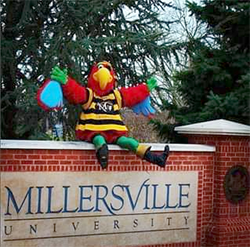Student Outcomes
The student outcomes for the major degree programs in the Department of Applied Engineering, Safety and Technology are listed below.
Appled Engineering & TEchnology Management (AETM)
A. Disciplinary Knowledge: An ability to select and apply the knowledge, techniques, skills, and modern tools of the discipline to broadly defined applied engineering activities.
Concentration Specific Disciplinary Knowledge Learning Outcomes:
Computer-Aided Drafting & Design: An ability to select and apply the knowledge, techniques, skills, and modern tools of the computer-aided drafting & design discipline.
Construction Management: An ability to select and apply the knowledge, techniques,skills and modern tools of the construction management discipline.
General Technology: An ability to select and apply the knowledge, techniques, skills, and modern tools of the discipline to manage complex projects and people in a technical environment.
Graphic Communication: An ability to select and apply the knowledge, techniques, skills, and modern tools of the graphic communication discipline.
B. Design: An ability to design systems, components, or processes for broadly defined applied engineering problems appropriate to program educational objectives.
C. Collaboration: An ability to function effectively as a member or leader on a technical team.
D. Oral Communication: An ability to apply oral and graphical communication in both technical andnon-technical environments.
E. Written Communication: An ability to apply written communication in both technical and non-technical environments.
Automation & Robotics Engineering TEchnology (AURO)
A. Disciplinary Knowledge: An ability to select and apply the knowledge, techniques, skills, and modern tools of the discipline to broadly defined applied engineering activities.
B. Design: An ability to design systems, components, or processes for broadly defined applied engineering problems appropriate to program educational objectives.
C. Collaboration: An ability to function effectively as a member or leader on a technical team.
D. Oral Communication: An ability to apply oral and graphical communication in both technical andnon-technical environments.
E. Written Communication: An ability to apply written communication in both technical and non-technical environments.
Manufacturing Engineering TEchnology (MFET)
A. Disciplinary Knowledge: An ability to select and apply the knowledge, techniques, skills, and modern tools of the discipline to broadly defined applied engineering activities.
B. Design: An ability to design systems, components, or processes for broadly defined applied engineering problems appropriate to program educational objectives.
C. Collaboration: An ability to function effectively as a member or leader on a technical team.
D. Oral Communication: An ability to apply oral and graphical communication in both technical andnon-technical environments.
E. Written Communication: An ability to apply written communication in both technical and non-technical environments.
Occupational Safety & Environmental Health (OSEH)
Graduates of the B.S. OSEH program will demonstrate:
- An ability to identify, formulate, and solve broadly defined technical or scientific problems by applying knowledge of mathematics and science and/or technical topics to areas relevant to the discipline.
- An ability to formulate or design a system, process, procedure or program for the intended purpose.
- An ability to develop and conduct experiments or test hypotheses, analyze and interpret data and use scientific judgment to draw conclusions.
- An ability to communicate effectively with a range of audiences.
- An ability to understand ethical and professional responsibilities and the impact of technical and/or scientific solutions in global, economic, environmental, and societal contexts.
- An ability to function effectively on teams that establish goals, plan tasks, meet deadlines, and analyze risk and uncertainty.
Technology & Engineering EDucation (TECE)
-
STUDENT LEARNING OUTCOME A: Knowledge & Practice in Content & Pedagogy Apply pedagogical and content knowledge expected of a preservice technology and engineering K-12 teacher.
-
STUDENT LEARNING OUTCOME B: Curriculum Development Demonstrate the ability to plan and prepare technology and engineering curriculum at a grade appropriate level.
-
STUDENT LEARNING OUTCOME C: Impact on Student Learning Evaluate their impact on students’ learning.
-
STUDENT LEARNING OUTCOME D: Professional Behavior Exhibit professionalism that is aligned to standards.
Master of Science in TEchnology & Innovation (EDTE)
- STUDENT LEARNING OUTCOME A (Communication Skills): Students will communicate clearly through the written word
- STUDENT LEARNING OUTCOME B (Critical Thinking, Decision Making & Problem Solving): Students will think critically in order to make sound decisions toward solving problems.
- STUDENT LEARNING OUTCOME C (Leadership): Students will demonstrate the characteristics of a good leader.
- STUDENT LEARNING OUTCOME D (Analytical Thinking): Students will use analytical thinking as one of their strategies for solving problems.
- STUDENT LEARNING OUTCOME E (Design Thinking): Students will use design thinking as one of their strategies for solving problems.
-
Schedule a visit to Applied Engineering, Safety & Technology
University Open House Days and Personal Tours Available. The best way to get to know us is to come and see us!
The best way to get to know us is to come and see us!Millersville University offers several opportunities throughout the year for you to visit campus and explore our academic programs, student life, financial aid, and the application process. You can find upcoming University Open House dates on the Admissions Department webpage.
We’re also happy to meet with prospective students and their families outside of scheduled open house events. Please contact us using the email or phone number below, and we’ll arrange a visit and connect you with a professor who specializes in your area of interest.
Email: AEST@millersville.edu
Phone: 717-871-7237 -
AEST News Blog and Department Information
Keep up on the latest things happening in and around the Department of Applied Engineering, Safety & Technology. You can see what the students and staff are doing right now.
Always know what's happening by reading the AEST News
-
Osburn Hall Building Hours
Office Hours:
7:30 a.m. - 4 p.m. Monday through Friday
Building Hours:
7:30 a.m. - 10 p.m. Monday through Thursday
7:30am - 4:30 p.m. Friday -
Resources for Professionals
 AEST Poster
AEST PosterDownload your copy of the Applied Engineering, Safety & Technology poster now. They look great in classrooms, guidance counselor's suites, or even in your dorm room!